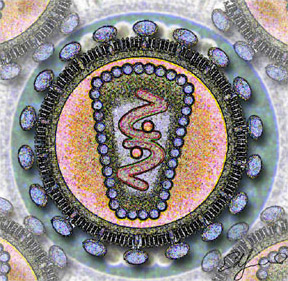n the fall of 2011 the world was shocked by the news of the first person ever cured of HIV and AIDS. Popularly known as 'the Berlin Patient', Timothy Brown's cure is quite literally a medical miracle, and it was actually more likely to kill him than cure him.
 Brown was a very sick man, having developed leukemia on top of HIV. Standard treatments for leukemia are radiation therapy and bone marrow transplants. The raditiation therapy, in addition to weakening the cancer, also killed most of the immune cells in his body. HIV reproduces in the immune cells, so the radiation also killed a great deal of the HIV and prevented it from replicating for a short period. It also left Brown even more vulnerable to infection than most people with AIDS. Even the mildest cold could have killed him.
Brown was a very sick man, having developed leukemia on top of HIV. Standard treatments for leukemia are radiation therapy and bone marrow transplants. The raditiation therapy, in addition to weakening the cancer, also killed most of the immune cells in his body. HIV reproduces in the immune cells, so the radiation also killed a great deal of the HIV and prevented it from replicating for a short period. It also left Brown even more vulnerable to infection than most people with AIDS. Even the mildest cold could have killed him.After the radiation therapy, Brown's doctor, Dr. Hutter, began a search for a bone marrow donor. As with all transplants, it was very important to find a donor with compatible tissue. If the donor and recipient aren't compatible, the recipient’s body will reject the transplanted tissue. In the case of a blood marrow transplant, that almost always means the recipient will die. Out of over 13 million potential donors, Dr. Hutter found around 230 who were compatible with Brown.
Rather than taking any one of those 230 possible donors, Dr. Hutter screened them for a gene known as the delta32 mutation of CCR5. The delta32 mutation gives the people who have it a natural resistance to HIV. Around the world, it is found in less than 1 in 100 people. Dr. Hutter found 1 person with the delta32 mutation who was also a compatible donor for Brown. In all, that is 1 person out of over 13 million who was both a compatible donor and possessed delta32.

They went ahead with the transplant, and were lucky again in that it was mostly successful. Between 10% and 40% of bone marrow transplants, the transplanted develops an infection or is rejected, even when compatible donors are found. The transplant was not totally successful – Brown had some severe side effects, and several years after the transplant is still in therapy to recover from some of them. At one point the side effects were so bad doctors had to induce a coma in order to treat some of them.
Luckily for Brown, the transplanted tissue with the delta32 mutation seems to have succeeded in preventing the HIV from reestablishing itself after the radiation therapy, and as of August of 2011 he is considered to be the first person officially cured of HIV.
 Unfortunately, the luck required to find a compatible donor with the delta32 mutation, the high risks associated with bone marrow transplants, and the severe side effects, make this 'cure' one that simply can't be used for the millions of people with HIV and AIDS around the world. Which doesn't mean a cure isn't possible. Researchers are currently looking for safer and more effective ways to give anyone with HIV the benefit of the delta32 mutation, and at least 6 clinical trials are currently underway or starting which are testing the potential of genetic therapies, vaccinations and other therapies that might one day be the cure.
Unfortunately, the luck required to find a compatible donor with the delta32 mutation, the high risks associated with bone marrow transplants, and the severe side effects, make this 'cure' one that simply can't be used for the millions of people with HIV and AIDS around the world. Which doesn't mean a cure isn't possible. Researchers are currently looking for safer and more effective ways to give anyone with HIV the benefit of the delta32 mutation, and at least 6 clinical trials are currently underway or starting which are testing the potential of genetic therapies, vaccinations and other therapies that might one day be the cure.The case of the Berlin Patient has not provided a useable cure for HIV. What it has done, after 30 years fighting HIV and AIDS, is prove that a cure is possible.
No comments:
Post a Comment